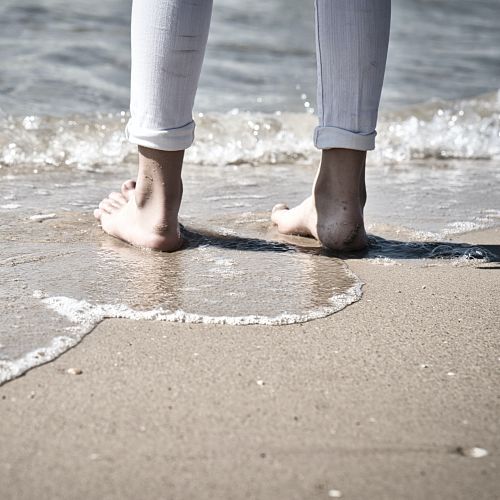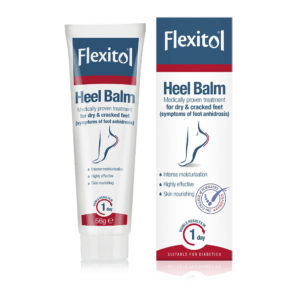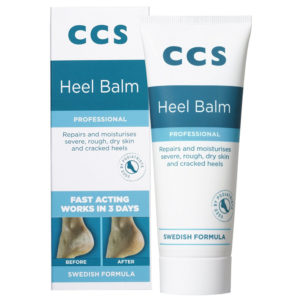Cracked Heels, also known as heel fissures or keratoderma, can occur for a number of reasons, such as a lack of moisture around the rim of the heel or from wearing footwear that exposes your feet. Other causes include obesity, cold and/or dry weather, standing on hard flooring for long periods of time, poorly fitting shoes, or an unnatural way of walking.
Cracked heels is an extremely common skin complaint that rarely causes any health issues; so while the brown or yellow crusty-looking skin is typically a cosmetic issue, when left too long cracked heels can become very painful. Of course, the best treatment is to prevent skin cracks from occurring in the first place, and it’s not hard to do. All that’s required is to rub your heels with a moisturising cream on a regular basis. This will keep your skin hydrated and supple.
Symptoms of Cracked Heels
Cracked heels are caused by tiny splits occurring in dry, damaged skin, and unless you regularly moisturise your heels and remove any dry skin, these skin tears can develop into deeper more painful cracks, called fissures.
While cracked heels might seem like a minor issue, they can significantly impact your daily life. Imagine wincing with each step as you walk to work or feeling self-conscious about wearing sandals on a hot summer’s day. It’s not just about looks – severe cases can lead to pain, bleeding, and even infections.
But don’t fret! With a bit of care and attention, you can banish those pesky cracks for good. Think of your heels as a garden – they need regular watering (moisturising) and occasional weeding (exfoliation) to thrive. Let’s dig deeper into what causes these cracks and how to heal them.
What Causes Cracked Heels
The most common reason people suffer from cracked heels is dry skin. When pressure and weight are applied to the pad under the heel, the skin expands to the sides, leaving the skin so dehydrated that it becomes stiff, less elastic, and likely to crack. The first sign of cracked heels is thickened, dry skin around the rim of the heel. This skin is called a callous. What you’ll notice initially are small cracks over the callous; however, if this is left untreated and more pressure is placed on the heel, you’ll quickly notice that standing and walking become painful as these cracks become deeper, perhaps even bleeding. In fact, cracked heels can become so severe that they become infected, leading to a condition known as cellulitis, which may require medical treatment with antibiotics, removing the dead tissue, and elevating the area.
Besides dry skin, predisposition to cracked heels may be caused by flat feet, diabetes, obesity, psoriasis, fungal infections, eczema, athlete’s foot, Sjogren’s syndrome, hypothyroidism, juvenile plantar dermatosis, and atopic dermatitis. Diabetic patients, in particular those who suffer from neuropathic damage (meaning loss of feeling in the feet), must be particularly careful as these fissures may well lead to diabetic foot ulcers.
The Best Treatments for Cracked Heels
Fortunately, you can obtain healthy, supple heels by treating your dry skin at home. At the first sign of cracked heels you should moisturise your heels 2 to 3 times a day. Alternatively, you can use a pumice stone to rub gently against the callus to remove most of the hard skin, then apply a moisturiser. Of course, if there is no improvement and your heels are still severely cracked after a week of home treatment, you must seek help from a podiatrist or your medical practitioner.
If you’re going to treat your cracked heels at home, we suggest trying the following steps –
- Lack of Moisture: This is the most common cause of cracked heels. This is partially due to the fact that the skin around your heels has a lack of elasticity and very few sweat glands, which can lead to rough, dry, chapped skin. Flexitol Heel Balm is an intense moisturiser designed specifically to prevent further water loss from dry, cracked heels. On application, your heels will immediately feel softer and more supple. The Balm should be applied two to three times a day, starting in the morning. Alternatively, you may want to try CCS Foot Balm For Rough Dry And Cracked Heels, part of the popular range of Swedish Foot Creams.
- Night Treatment: Apply a thick layer of Flexitol Intense Overnight Foot Treatment to your feet before going to bed, and then put socks on. The socks will stop spreading the ointment onto your bed linen as well as keeping your feet nice and moist all night.
- Soak – Moisturise: A great way to relieve stress is to soak your feet in a bowl of warm water with a few added drops of soothing essential oils, like lavender oil. Within 10 to 20 minutes your feet will feel lovely and soft, making it much easier to use a pumice stone to exfoliate excess dryness away. Don’t forget to use moisturiser afterwards.
- Try A Foot Pack – our Derma V10 Calming Lavender Foot Pack is enriched with Lavender Oil, Cranberry Extract and Vitamin E to deeply moisturise the skin helping to soothe and soften dry, rough and cracked heels.
- Cushion Your Shoes: Many of today’s fashionable shoes have hard soles, which places extra pressure on the feet. Try adding extra cushioning with heel pads or adding a soft insole. While your heels are still recovering, change your footwear to wearing slippers indoors and more comfortable shoes, like trainers, outdoors.
Seek Medical Help
If you feel that your cracked heels are beyond self-treatment at home, make an appointment to see your GP or podiatrist as soon as possible to check for any possible underlying cause. If you have diabetes, psoriasis, or eczema, it’s probably best to seek professional treatment rather than trying to cope at home.
Photo by Adi Goldstein on Unsplash
Zoom Health is a leading UK supplier of Home Health Tests and Earplugs







